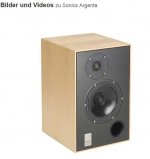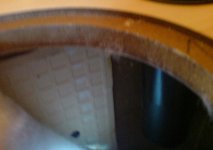I think you'd be better off with a good grade of silicone caulk. Duct seal has no memory. Squeeze it and it stays put. You want a little rebound. You could cut the bracing a 1/2" under size and shim for 1/4" spacing ... caulk and let it cure ... pull the shims and finish the caulking. No fasteners.
Last edited:
Ohm originally installed their speakers with RTV. I think it was done solely for ease of assembly, however. Nasty, stinky stuff, and I've heard the fumes don't play nicely with modern adhesives in the drivers.
I have been doing alot of reading here:
Room Acoustics
and about how the current loudspeakers are directional only in the upper frequencies. Which got me thinking. Where would a lossy box fall in this sort of diagram? They are made so that they are essentially accoustically transparent in the upper frequencies but they will still become directional at some point....
Room Acoustics
and about how the current loudspeakers are directional only in the upper frequencies. Which got me thinking. Where would a lossy box fall in this sort of diagram? They are made so that they are essentially accoustically transparent in the upper frequencies but they will still become directional at some point....
They are made so that they are essentially accoustically transparent in the upper frequencies but they will still become directional at some point....
No no no!
Lossy boxes are not transparent. They should have high mass with high damping. This will make their sound transmission quite low. If you make a box that is high mass, high stiffness, but no loss, then it will be transparent at each resonance.
This will not impact the polar response (the radiation is never that great) but it will be heard as resonances or coloration.
David S.
High Mass? But they are made from thinner sheets of wood with little to no bracing.
Do you mean high mass in the fact that they have bitumen and lots of dampening like poly?
Do you mean high mass in the fact that they have bitumen and lots of dampening like poly?
High Mass? But they are made from thinner sheets of wood with little to no bracing.
Do you mean high mass in the fact that they have bitumen and lots of dampening like poly?
Right. The loss occurs in the wall, not through the wall.
"BBC thin wall" design isn't really thinner, and certainly isn't lighter than typical MDF or plywood construction. The key difference in the concept is, (altogether now) more of the wall mass is damping rather than structural stiffness.
The whole idea of a "lossy cabinet" is that there will be less sound on the outside.
Ok, i see what you mean....
I think I am going to have to build every "Style" of box imaginable. I am most fascinated by dipole/open baffle like Linkwitz designs and Lossy cabinets. However, so many people I have spoken to really push the styles that they prefer.
I cannot tell you how many people have told me that the best speaker is one with a horn. Don't get me wrong, I am sure that it has many benefits and I intend to try them as well.
However, the best I have ever heard still has been some Wilson Maxx speakers which were not too "forward".
I like the laid back yet detailed sound which I find very relaxing yet involving.
I think I am going to have to build every "Style" of box imaginable. I am most fascinated by dipole/open baffle like Linkwitz designs and Lossy cabinets. However, so many people I have spoken to really push the styles that they prefer.
I cannot tell you how many people have told me that the best speaker is one with a horn. Don't get me wrong, I am sure that it has many benefits and I intend to try them as well.
However, the best I have ever heard still has been some Wilson Maxx speakers which were not too "forward".
I like the laid back yet detailed sound which I find very relaxing yet involving.
Hobby HiFi have done a alot of measurements of various ways of bracing or adding damping material to loudspeaker walls. And multi layers seem to be the way to go. Gluing ceramic tiles is good as is 4mm bitumen pads, or surprisingly soft board. Topping these off with gluing on a felt layer seem to be synergistic. That is MDF+Something+felt is better than you would expect looking at MDF+felt and MDF+something.
The Spendor BC1 use a soft board glued to 10mm plywood not a lining with thick bitumen.
The Spendor BC1 use a soft board glued to 10mm plywood not a lining with thick bitumen.
Gawd, 15 pages of waffle, and finally an interesting idea beyond the use of simple rigid plywood and a bit of damping and a bit of restraint on bracing! 😀
Ceramic tiles on the panels. Joachim Gerhard did this in his Sonics Argenta Speaker. Anybody else get it? I know where he was heading on this. I'm not saying Joachim Gerhard would argue this is the best way to do things, but what was the guiding principle? That is the right question from which you will learn something. 😎
Ceramic tiles on the panels. Joachim Gerhard did this in his Sonics Argenta Speaker. Anybody else get it? I know where he was heading on this. I'm not saying Joachim Gerhard would argue this is the best way to do things, but what was the guiding principle? That is the right question from which you will learn something. 😎
Attachments
did that 20 years ago, using lead/rubber sheet(for boat motors)
I glued it on almost every hifi equipment I owned
until one day I noticed some of it began to loosen and 'let go'
in which case it could be worse than nothing
so I got tired of it, and dropped it
but today you can get this special coating for bathrooms etc
its kind of rubber like, and very strong tough stuff
might try a few experients with that
I glued it on almost every hifi equipment I owned
until one day I noticed some of it began to loosen and 'let go'
in which case it could be worse than nothing
so I got tired of it, and dropped it
but today you can get this special coating for bathrooms etc
its kind of rubber like, and very strong tough stuff
might try a few experients with that
I used ceramic tiles on the outside back panel to get it more stable. Worked rather well I think.
I used ceramic tiles on the outside back panel to get it more stable. Worked rather well I think.
good sweedish ones I take it
I would try 'plasterboard'
it is very 'dead'
plaster board is good. I made a test box several years ago, 6mm MDF lined with plaster board lath, carpet tile and felt. Like ceramic its fairly reflective, or more so than the 'wood'.
The box was relatively light, compared to 18mm MDF, and sturdier than i expected.
The box was relatively light, compared to 18mm MDF, and sturdier than i expected.
Last edited:
I was just reading about KEF LS50 and there cabinet vibrations were minimized using a damping layer between braces and box shell. Rubber might be too stiff but bitumen pads could work best. Stiff connection between box and braces makes vibration go higher and to a more easily audible area.
I think knock test is still relevant. The shorter, lower and quieter (duller) the knock-sound, the better.
I was considering using duct seal. for the "mastic" in my new cabinets between a cross-brace and the cabinet.
Thoughts?
I think you'd be better off with a good grade of silicone caulk. Duct seal has no memory. Squeeze it and it stays put. You want a little rebound. You could cut the bracing a 1/2" under size and shim for 1/4" spacing ... caulk and let it cure ... pull the shims and finish the caulking. No fasteners.
Are you sure silicone caulk would be the right choice?
I don't really understand the rational here: bracing is normally used to make the enclosure stiffer whereas here it is used to dampen the enclosure.
I don't see excaly how using bracing in such a manner would be better than simply puting silicone caulk spots on the same area you would have attached the braces to, whithout the braces themself. 😕
Here is a video of Kef's approach:
KEF LS50 - YouTube
I would be very interested in seing the interior of this enclosure for real, to see what kind of material they are using for these dampening pads, and also its thickness...
I have a small two way (around 20L) that I was planning to add bracing to the weekend, but I would really like to try this approach with silicone if it is the proper material.
Are you sure silicone caulk would be the right choice?
I don't really understand the rational here: bracing is normally used to make the enclosure stiffer whereas here it is used to dampen the enclosure.
I don't see excaly how using bracing in such a manner would be better than simply puting silicone caulk spots on the same area you would have attached the braces to, whithout the braces themself. 😕
Here is a video of Kef's approach:
KEF LS50 - YouTube
I would be very interested in seing the interior of this enclosure for real, to see what kind of material they are using for these dampening pads, and also its thickness...
I have a small two way (around 20L) that I was planning to add bracing to the weekend, but I would really like to try this approach with silicone if it is the proper material.
Thanks for the video. I hadn't yet seen it.
The LS50 "White Paper" was what got me thinking about this stuff, too. It's probably of marginal import (if that), but who knows.
I don't see excaly how using bracing in such a manner would be better than simply puting silicone caulk spots on the same area you would have attached the braces to, whithout the braces themself. 😕
oh yes, it makes the whole difference
silicone on its own does nothing
the key is to look at it like two different material joined together to work opposite ways
if you glue them tightly together it would be more like creating a new hybrid material
oh yes, it makes the whole difference
silicone on its own does nothing
the key is to look at it like two different material joined together to work opposite ways
if you glue them tightly together it would be more like creating a new hybrid material
so you are bracing it in a fashion that will still allow flex?
question is, how much flex....or, which kind of flex
Kinda make you wonder what would happen if the bracing was more like an elastic/bitumen substance that is connecting/controlling the flex of the cabinets like a spring strung between parallel walls of the box compared to the hard wood braces.
- Home
- Loudspeakers
- Multi-Way
- Interesting read I found on Lossy Cabinet designs by Harbeth

